
Antirrhinum is a genus of plants commonly known as dragon flowers, snapdragons and dog flower because of the flowers' fancied resemblance to the face of a dragon that opens and closes its mouth when laterally squeezed. They are native to rocky areas of Europe, the United States, Canada, and North Africa. It is widely used as an ornamental plant in borders and as a cut flower.
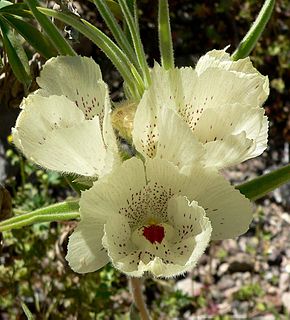
Mohavea confertiflora, the ghost flower, is a plant of the family Plantaginaceae. It is a native of the Southwestern United States, southern California, and three states of northwest Mexico.

Mentzelia involucrata is a species of Mentzelia native to the Mojave and Sonoran deserts of North America as well as places in Nevada, Arizona and Baja California (Mexico). Its common names include kuʼu, sand blazing star and white-bract blazing star.

Distichlis spicata is a species of grass known by several common names, including seashore saltgrass, inland saltgrass, and desert saltgrass. This grass is native to the Americas, where it is widespread. It can be found on other continents as well, where it is naturalized. It is extremely salt tolerant.

Mohavea is a plant genus consisting of two species native to the deserts of the southwestern United States and northern Mexico. This genus is often included in the closely related snapdragon genus Antirrhinum.
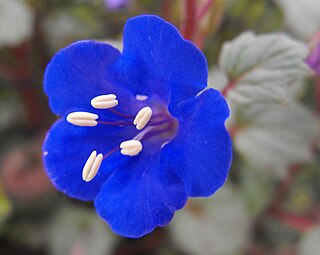
Phacelia campanularia is a species of flowering plant in the borage family, Boraginaceae, known by the common names desertbells, desert bluebells, California-bluebell, desert scorpionweed, and desert Canterbury bells. Its true native range is within the borders of California, in the Mojave and Sonoran Deserts, but it is commonly cultivated as an ornamental plant and it can be found growing elsewhere as an introduced species.
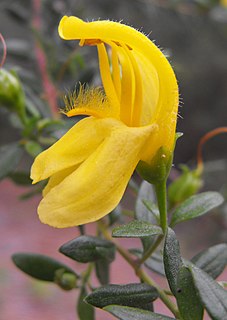
Keckiella antirrhinoides is a species of flowering shrub in the plantain family known by the common names snapdragon penstemon and chaparral beardtongue.

Acanthomintha ilicifolia, known by the common name San Diego thornmint, is a rare species of flowering plant in the mint family. It is native to Baja California and San Diego County, California, where it is a resident of the chaparral and coastal sage scrub plant communities and vernal pools.
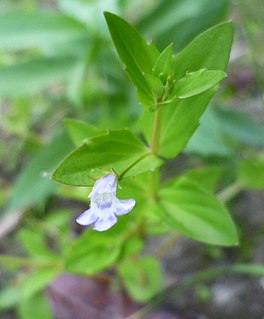
Lindernia dubia is a species of flowering plant known by the common names yellowseed false pimpernel and moist bank pimpernel. It is a member of the "new" plant family Linderniaceae, and it is sometimes treated as a member of the families Scrophulariaceae and Plantaginaceae. It is native to much of the Americas from Canada to Chile, and it can be found on other continents as an introduced species. It grows in wet habitat, such as riverbanks, pond margins, and meadows. It is an annual herb growing a mostly erect, branching stem to exceed 30 centimeters in height. The oppositely arranged leaves vary in size and shape, from lance-shaped to oval, toothed or not, and under one to over three centimeters long. Flowers emerge from upper leaf axils. Each has a calyx of five narrow, linear sepals. The tubular corolla is up to a centimeter long, white in color with a blue or purple tint, and lipped at the mouth, the lower lip with three rounded lobes. The fruit is a capsule containing yellow seeds.

Loeseliastrum schottii is a species of flowering plant in the phlox family known by the common name Schott's calico. It is native to the southwestern United States and northern Mexico, where it is common in many parts of the desert region. It is a small, hairy annual herb with alternately arranged leaves each up to 4 centimeters long and edged with long bristle-tipped teeth. The flower generally has three lobes on its upper lip and two on its lower. It is spotted to mottled in pattern, varying in color from purple-speckled white to orange-speckled yellow, sometimes with reds and pinks. The protruding stamens are curved and tipped with yellow anthers.

Mimulus ringens is a species of monkeyflower known by the common names Allegheny monkeyflower and square-stemmed monkeyflower.

Erythranthe shevockii is a rare species of monkeyflower known by the common name Kelso Creek monkeyflower. It was formerly known as Mimulus shevockii.

Nemacladus glanduliferus is a species of flowering plant in the bellflower family known by the common name glandular threadplant. It is native to the southwestern United States and Baja California, where it grows in desert and plateau habitat. It is an annual herb producing a purplish or brownish green, branching stem up to about 25 centimeters tall. Small oval leaves occur at the base of the plant. The inflorescence is a series of zigzagging branches bearing occasional flowers on thin, erect pedicels. There is a single small bract at the base of each pedicel. The flower at the curved tip of the pedicel is just a few millimeters wide. There are five pointed sepals and five white corolla lobes, generally three in the upper lip and two in the lower.

Orthocarpus luteus is a species of flowering plant in the broomrape family known by the common name yellow owl's-clover. It is native to much of western and central North America, where it grows in many types of plateau, grassland, and mountain habitat.
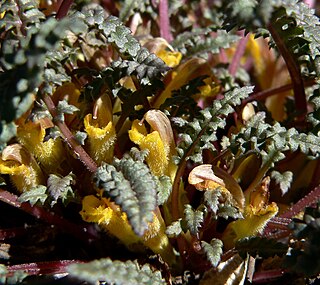
Pedicularis semibarbata, known by the common name pinewoods lousewort, is a species of flowering plant in the family Orobanchaceae.

Penstemon clevelandii is a species of penstemon known by the common name Cleveland's beardtongue. It is native to southern California and Baja California, where it grows in mountain and desert habitat such as scrub, woodland, and chaparral. It is a perennial herb with upright, branching stems 70 centimeters in maximum height. The thick leaves are oval in shape, sometimes toothed, and 2 to 6 centimeters in length. The inflorescence produces tubular flowers with expanded, lipped mouths. The flower is pink to magenta in color, up to 2.4 centimeters in length, and somewhat glandular on the outer surface.

Penstemon floridus is a species of flowering plant in the plantain family known by the common names Panamint beardtongue and rose penstemon.

Proboscidea parviflora is a species of flowering plant in the family Martyniaceae known by the common names doubleclaw and red devil's-claw. It is native to the desert southwest of the United States and northern Mexico, where it grows in sandy, dry, and disturbed habitat and blooms during the hot summer. This is an annual herb growing from a taproot and producing sprawling, spreading stems. The leaves have rounded, oval, or roughly triangular blades up to 15 centimetres (6 in) long which have smooth edges or faint lobes or teeth. The inflorescence is an array of several showy bell-shaped flowers with five lobes flaring several centimeters wide. The flower is white to pink or purple, sometimes with mottling or lines of spots in the throat, and often a purple blotch on the upper lip. A yellow nectar guide extends along the lower lip. The fruit is a large seed pod many centimeters long, a cylindrical body tapering into a very long, thin, curving tail. As the fruit dries the tail cracks open and splits into two hooked, claw-like halves. The young fruits and seeds were used for food and the dark-colored hardened dry fruits were used in basketry by local Native Americans.
Salvia greatae is a species of flowering plant in the mint family, Lamiaceae. Its common names include Orocopia sage and lavender sage.
Erythranthe hymenophylla, synonym Mimulus hymenophyllus, is a species of flowering plant in the lopseed family known by the common names thinsepal monkeyflower and membrane-leaf monkeyflower. It is native to Hells Canyon on the border between Oregon and Idaho in the United States. It has also been reported from Montana.

















